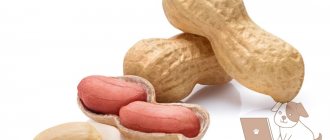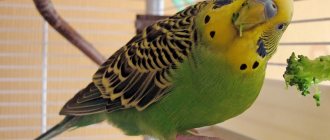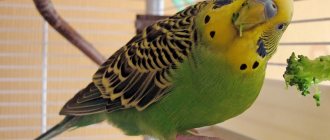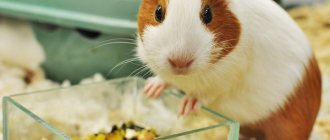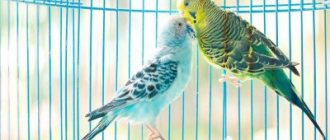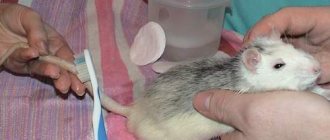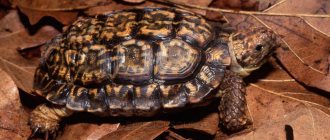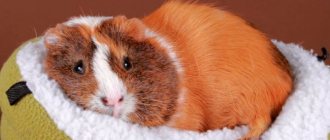Budgerigars are the most popular breed, most often chosen by owners as a pet. Due to its activity and the sounds it makes, it brings a huge amount of positive emotions to its owners. In return, the birds only ask for attention and do not refuse the treats that the owner can give. It is very important to pay special attention to nutrition, since the health of the bird greatly depends on it.
Fruit diet
Parrots are not very picky about their diet. The pet must be constantly given sprouted grain, periodically adding fruits, vegetables and berries. They contain a wide variety of microelements, vitamins and minerals.
All microelements are necessary for the problem-free growth of the bird and the prevention of various diseases.
Without berries, fruits and vegetables, it will be very difficult for a parrot to grow. Moreover, birds can be quite picky; not all of them can peck cut fruits or berries. In this case, the owner needs to twist and cut them into very small pieces, use a grater or prepare puree
A number of birds, on the contrary, prefer large pieces, in which case they must be attached to the bars of the cage.
The ideal option for choosing a root vegetable is one that has grown in the garden or vegetable garden. But not all owners have this opportunity. And root vegetables from the store are often picked unripe, then sprayed with special chemicals, transported over vast distances, and then they lie on store shelves for a long time.
With such fruits, you need to do a little preparation - remove all the peel and pit, and then give it to your pet to eat.
It is also worth familiarizing yourself with a number of tips to reduce potential problems with feeding and accustoming your pet to new food:
- To introduce your parrot to a banana for the first time, it is best to put dry food inside, and then attach the entire piece to the bars of the cage. The parrot will peck at familiar food and will immediately appreciate the taste of the new treat.
- To attract birds to new food, it is better to use a variety of types of presentation. You can make fruit salads, chop root vegetables, grate them, make purees or freshly squeezed juice.
- You need to mix the main food and fruit and vegetable supplements. Thus, sooner or later the bird will try an unusual new product, and he will like it. At the same time, it is necessary to update the feeder in a timely manner, otherwise there is a high risk that the new product will deteriorate.
- It would be a good idea to purchase several holders for new products and place them inside the parrot's cage. There is a high probability that the bird will want to play with a new delicacy and sooner or later will appreciate the new product.
- If your bird does not enjoy eating raw fruits, you should dry them. In this case, you need to pour hot water over the selected fruit. Prunes, dried apricots, and figs are suitable.
- One option to accustom a bird to juicy fruits is to nibble on an apple or pear in front of its eyes. The pet will definitely be interested in the “yummy” in the hands of the owner and will try to try it.
Thanks to these simple tips, you can accustom your bird to a large number of sweet treats. Now you need to figure out which sweets the birds can eat and which they cannot.
Apples
These fruits are rich in fiber, tannins, vitamins B and C. It is imperative to cut off the peel before feeding. It is also necessary to cut out rotten places and blackening, remove the seeds with a knife or a special device.
A maximum of 1/6 of the total fruit can be given to birds per day. The best way to prepare it is to grate them or chop them very finely.
Birds can be quite picky, so don’t be afraid to experiment - dry or soak an apple, grate it or squeeze out juice.
Pears
Pears are good for the health of birds; the pectin they contain improves digestion. Carbohydrates, iron and phosphorus are also essential microelements found in fruits. Before serving, remove the peel and seeds. There are no restrictions on feeding, but it is better not to let the bird overeat.
Orange
Citrus fruits contain many carbohydrates, fiber and essential oils. Their use helps strengthen the immune system, protecting the body from various diseases. It is enough to feed the bird a small amount of oranges a day, you can give fresh juice.
Mandarin
This citrus contains a lot of useful substances. Among them are potassium, magnesium, many acids, fiber and carbohydrates. It is necessary to remove the peel in advance, cut it into small pieces, place a drinking bowl nearby and constantly update the water in it.
Before feeding, you need to check if your pet is allergic to the “yummy”. To do this, you need to give the bird a very small piece of tangerine and monitor the reaction to consumption.
Grapefruit
If there was no allergic reaction to tangerine, you can include other citrus fruits in your diet. Grapefruit also benefits from high amounts of vitamins, fiber, and carbohydrates. It is also necessary to remove the skin before feeding.
Lemon, lime
The situation is similar with these sour citrus fruits. They can be given in the form of small pieces, having previously been cleared of scales. The second option is to prepare freshly squeezed juices, diluting them with water.
Peach
Very sweet taste, characterized by the presence of a huge amount of sugar, fiber and other vitamins. You can give them to the bird fresh or dried. You need to remove the pit and remove the skin in advance.
Apricot
The composition contains sugar, starch, inulin, iron and various acids. Consumption can reduce the risk of heart disease. Can be fed in dried form.
Plum
The composition contains fiber, vitamins and sugars. Consumption is similar to other fruits - fresh or pre-dried. Be sure to remove the pit before serving.
Grape
You don’t have to remove the seeds; giving a few berries a day is enough. Allows you to get the missing vitamins and microelements. It also helps cleanse the bird’s body.
Pomegranate
Improves heart function. Every day it is enough to give a couple of grains, increasing their quantity each time. The maximum limit is one sixth of the entire fruit.
A pineapple
Thanks to its use, it is possible to eliminate the deficiency of manganese and calcium, which are necessary for normal growth and healing of bones.
Kiwi
Contains a large amount of vitamin C, accelerates the healing of various wounds. Lowers cholesterol and reduces the likelihood of getting sick due to the presence of vitamin E. It is necessary to peel and cut the fruit.
Banana
Also rich in minerals, vitamins, sugar and starch. It can be given as a treat in a variety of variations - fresh and dry. It is necessary to remove the peel and cut into small pieces. They can be placed in a feeder, having previously been filled with sprouted grain, or strung on the bars of the cage.
Melon
A real treasure trove of vitamin A, it contains phosphorus, iron, potassium and sodium. Improves the functioning of the digestive system. It is necessary to cut into small pieces.
It is better to feed your parrot with fruits that have grown in season.
Feijoa
The peculiarity of this type of exotic fruit is a large amount of iodine. A few pieces a day are enough.
Pomelo
An unusual Chinese citrus, which will also not be out of place in the diet, especially if there is such an opportunity.
How to train a parrot to eat fruit?
Firstly , it is worth presenting the parrot with fruits in various forms - slices, pureed, large pieces and even in the form of freshly squeezed juice. Experiment and combine the form in which you present food to your pet: rub, mix or give in the form of juice. It is worth noting that the juice is very easily absorbed in the digestive system. For example, green juice from kale and dandelion is best mixed with carrots and apples. The bright orange color of carrot juice and its sweet taste are generally enjoyed by parrots. And the vitamin A contained in the juice boosts the immune system and is a powerful antioxidant. Parrots are able to absorb almost 100% of the beta-carotene in carrot juice, versus 1% when they simply eat fresh carrots.
Secondly , eat healthy foods in front of your feathered pet yourself. The birds' curiosity and the owner as a role model are the best ingredients for persuasion.
Thirdly , use special accessories and holders with which you can bring food into the cage. These are plastic clips and various types of fruit holders in the form of skewers and skewers. Such accessories can be perceived by birds as a fun toy. And the chances that your pet will simply try a new product will increase.
If, despite all your efforts, your feathered friend simply bites off and throws away everything you offer him, do not be upset. In this case, even a drop of juice gets to the parrot. Give the bird time to taste the treat. Your patience and perseverance will be rewarded!
Berry diet
In addition to fruits, parrots are very fond of berries. They can be eaten fresh or pureed. It is better to choose fresh rather than store-bought fruits, especially if possible. A good option is to cook compote from different berries. It needs to be brought to a boil; there is no need to add sugar.
Raspberries
Raspberries also help improve immunity very well and are used as a preventive measure not only by people, but also by birds. Most parrots prefer to eat it as a treat.
It is better to purchase sweet varieties.
Currant
Rich in various vitamins and microelements. It is not necessary to remove the seeds, but it is better to remove them from the branches. It would be a good idea to make sweet puree.
Gooseberry
Gooseberries must be given to birds in their entirety, removing the fruits from the branches. You can feed whole fruits or mix them into purees. You can also cook unsweetened compote.
Strawberry
The berry is rich in vitamin C and antioxidants. Preference should be given to fresh berries. If possible, you should pay attention to the amount of nitrates in the product; if they are exceeded, it is better to remove them from the diet. They can be pre-frozen, the vitamins from the composition will not go anywhere. But before serving, you need to warm them up a little, otherwise the parrot may catch a cold and get sick.
Strawberries
Strawberries differ from strawberries or raspberries in slightly less sugar, but the amount of microelements is no less. It is better to alternate its use with sweeter fruits.
Cherry
Rich in fiber, sugar and various microelements. You can serve it in any convenient form; remove the bone first.
You can leave it for your pet as entertainment and exercise for the beak.
Cherries
It is most similar to cherry in its composition. The feeding procedure is similar.
Blackberry
Blackberries are good for pets. It improves vision and helps improve immunity. No chemicals are used during cultivation, which means there is no harm.
Blueberry
A very sweet berry that should be given to your pet occasionally.
If it is not possible to purchase fresh food, it is better to wait for the season. Otherwise, there is a high probability that the bird will not eat the treat.
Blueberry
It’s quite difficult to get fresh blueberries, so if the opportunity arises, it’s better to take more and freeze them for the future. Warm slightly before serving. Will strengthen the immune system.
Cranberry
If the owner likes to walk through the forests to pick berries or mushrooms, it would be useful to collect a certain amount of cranberries. The feathered one will appreciate the delicacy. First you need to remove the fruits from the branches.
Cowberry
The situation is completely similar to cranberries. It’s better to assemble it yourself and choose something rarer in the store. Stir into puree before serving.
Kalina
Viburnum is quite easy to grow in your own garden. If you add raspberry, gooseberry and cranberry bushes to the tree, the bird will be very happy with the delicious compote made from these fruits.
Rowan chokeberry
Rowan should first be dried, since birds do not really like it fresh. Before serving, add water and soak a little.
Allows you to get a large number of different microelements and vitamins.
Red rowan
The main difference from the berry from the previous paragraph is less sugar. It contains no less vitamins and microelements. It is also better to dry it first.
Rose hip
Rose hips are popular as an immune-supporting food. It is also recommended for use by feathered pets to prevent various diseases. The ideal option is to make puree or cook unsweetened compote.
What fruits can you give your parrot?
Apples, pears, oranges, tangerines, grapefruit, bananas, grapes, peaches, apricots, plums, cherries, raspberries, currants, gooseberries, strawberries, blueberries, watermelon, melon, pineapple, kiwi - all these berries and fruits can be given to a parrot. Below are some useful tips for each of them.
Everything you offer your pet must be washed thoroughly, even if it comes from your environmentally friendly summer cottage. Fruits can be offered both fresh and dried. By dried we mean homemade. Candied dried fruits in a regular store are not suitable for parrots. You should also remember that such tropical overseas wonders as papaya and mango, which are often brought to Russia unripe, which makes them toxic to birds. Therefore, if you are not sure about the ripeness of papaya and mango, then it is not recommended to give them.
What not to give
The birds are very happy with the various treats that their owners give them. The diet can be quite extensive, but there are still a number of fruits that should never be given to your pet.
The consequences can be very diverse.
Persimmon
When consuming this fruit, there is a high probability that your pet will develop problems with the gastrointestinal tract. It is not a toxic fruit, but it is better to protect yourself and your pet. If there is a strong desire to feed a bird with persimmons, you need to give it an absolutely fresh product, having first peeled it.
Avocado
The main disadvantage of avocado is the presence of a large persin. It is extremely toxic and its consumption can lead to the death of the bird. For this reason, it is better to exclude avocados from your diet.
Mango
This is a very popular fruit that birds eat in the wild. It is rich in various vitamins, contains a lot of fiber and various salts. However, it is not recommended to give it to your pet as a treat, otherwise there is a high risk of various diseases due to the presence of a huge amount of essential oils and tannins in the composition.
Papaya
Like all exotic fruits, it can be dangerous to the health of your budgie.
The point is a large number of different essential oils and tannins. They can have a negative effect not only on the functioning of the digestive tract, but on health in general.
Grain mixture
The main food for lovebirds is a grain mixture. It should make up at least 60% of the daily diet. Grain feed can be purchased ready-made, or you can prepare it yourself. Of the ready-made lovebird mixtures, food is only suitable for medium-sized parrots. It is not recommended to use ready-made food for small and large species.
The most common brands of grain mixtures for lovebirds: Rio, Padovan, Fiory, Versele-Laga. You can buy this food at any store.
Before purchasing, you must check the expiration date. The grains must be in sealed packaging. Before feeding, grain must be checked for quality. The surface of the grains should be smooth and glossy, there should be no damage or musty smell.
The grain mixture includes: red, yellow and black millet, oats, wheat, corn, canary seed, rapeseed, sesame, buckwheat, hemp seed, Abyssinian noug, safflower, as well as pieces of dried vegetables and fruits.
The daily norm of grain mixture for lovebirds is 2-3 teaspoons.
What to look for when choosing fruits and berries
When choosing fruits, you need to pay attention to their freshness. Exotic fruits that do not grow in a certain region or in the Russian Federation in general are very often picked unripe, sprayed with chemicals and then taken to store shelves. Because of this, the fruits need to be washed thoroughly, and it is better to remove the peel. Also, if possible, you should take fruits grown in your own garden or garden.
Greenery and tree branches
Green food in the diet is no less important than grain and succulent food. Greens contain a large amount of moisture, and thanks to the twig food, the parrot wears down its beak every day.
- What greens can be given to a lovebird: dandelion, plantain, nettle, plantain, lettuce, carrot tops.
- The branches of which trees can be fed to the lovebird: birch, willow, aspen, hawthorn, alder, ash, linden, elderberry, maple, apple, viburnum, cherry, rowan, raspberry, currant.
It is best to collect greenery and tree branches from summer cottages. In urban areas, you can only collect away from the road, where there is no dust and dirt. The greens need to be washed under running water and fed to the parrot. Tree branches must be cleaned of dirt, washed under water, and then scalded with boiling water to destroy the parasites that live in the bark. The branches need to be cut into small pieces, 5-10 cm long, and left in the cage.
Prohibited Products
A balanced diet is an important condition for a full life for a parrot. Owners strive to feed their pet tasty and satisfying, but sometimes they include prohibited foods in the diet:
- Spices and seasonings provoke severe damage to the digestive system, including the death of the bird.
- Milk and cheese. The parrot's body does not produce enzymes to digest dairy products, so the food simply rots.
- Fungi cause kidney failure in poultry.
- Salt. Parrots happily eat salty grains, but in large doses, salt is a deadly poison.
- Chocolate. Feeding cocoa and sugar has a stimulating effect on the bird's nervous system.
The diet of budgies can be varied without involving prohibited foods. Birds are very fond of nuts, fruits and honey sticks.
Treats.
Walnuts are a favorite treat for parakeets. They adore them and are ready to do anything to get them for lunch, breakfast or dinner. Therefore, we advise you not to give your parrot a nut just like that, but to use it during training as a reward for any, even the smallest, achievements. For wild parrots, such an achievement may be a simple “fly on the shoulder”, for tame ones - for more complex tricks. Parrots also love other types of nuts: peanuts, hazelnuts, pine nuts.
You can give crushed chestnuts and acorns. But remember: you can’t give too many nuts. Everything is good in moderation. And it is better to give the nuts not completely peeled, but split, so that the bird can get the nut out of the shell itself. This is another way to satisfy her desire to chew on something. Fresh pomegranate seeds. Ooo! This is a real treat for the necklace parrot. If you offer him a choice of pomegranate, orange or apple, then most likely he will choose the first one. You can also use this to tame a bird.
Chumiza in spikelets is the No. 1 delicacy for necklace parrots. It should be given 1-2 times a week - no more often. Otherwise, you will spoil the bird and it will refuse to eat regular food.
What else can you feed lovebirds besides food?
- Boiled egg;
- Low-fat cottage cheese;
- Low-fat kefir, yogurt, fermented baked milk;
- Chalk, sepia, eggshell, bone meal.
This feeding is important and strengthens bone tissue at an early age, useful for the growth and development of the chick. It is also important to support the body of lovebirds during the nesting period. Laying and incubating eggs takes a lot of strength and energy from a parrot.
It is worth considering that fermented milk products quickly deteriorate, so you need to prepare a separate feeder for them, which must be removed from the cage half an hour after feeding.
Rules for feeding lovebirds
- Grain feed should make up at least 60% of the diet. This is the main food that a lovebird should eat daily.
- Vegetables and fruits must be alternated; you cannot give the same foods every day.
- It is necessary to feed lovebirds at the same time.
- When keeping two birds in one cage, a separate feeder must be provided for each. When keeping a large number of birds, you can use one large feeder so that all the birds have enough space and there are no fights for food.
- The water in the drinking bowl needs to be changed every day, since debris and grain husks often get into the drinking bowl.
What not to feed lovebirds
It is important to know not only what you can give your lovebird parrot to eat, but also what you cannot feed it. Since this can not only negatively affect the health of the bird, but also lead to its death.
Prohibited List:
- food from the table;
- fried, salted, smoked, spicy;
- onion garlic;
- oak and pear branches (contain tannins that are dangerous for birds);
- branches of coniferous trees (contain resin);
- exotic fruits: mango, persimmon, avocado, papaya;
- potatoes, eggplant;
- sweets;
- mushrooms;
- pits of cherries and sweet cherries (contain hydrocyanic acid).
Before getting lovebirds, you need to study not only the rules for care and maintenance, but also find out what you can feed lovebirds at home. Poultry nutrition is the main factor that affects health and life expectancy. An active and cheerful bird will delight all family members for a long time.
Vegetable menu
Your budgerigar should be fed fresh vegetables daily.
Vegetables that should be present in a bird’s diet:
- Beijing, cauliflower, white cabbage and broccoli contain a lot of useful substances, improve metabolic processes, and quickly cleanse the body of toxins.
- Pumpkin will help your bird stay alert and energetic, regulate water-alkaline balance, strengthen the vascular system, and improve intestinal motility.
- Carrots, rich in carotene, pantothenic and ascorbic acid, can be given to your budgie daily. It is especially useful during the growth period of the bird. Regulates hemoglobin levels, improves vision.
- Cucumber dissolves sand and kidney stones, improves blood properties and perfectly cleanses the intestines of birds.
- In terms of its biochemical composition, beets are a leader among other vegetables. Thanks to antioxidants and a large number of other beneficial microelements, beets are an essential element of the diet for a budgie.
- Bell peppers of both red and green varieties will replenish the bird’s body with useful substances in an easily digestible form and a powerful source of vitamin C. You should make sure that this is a variety of sweet and not bitter pepper before offering it to the bird.
- Tomatoes are a source of good health and longevity. They normalize metabolism and prevent the occurrence of infectious diseases.
You can offer your bird sun-dried tomatoes, preparing them in small batches. Pumpkin is offered baked, fresh and as part of crumbly porridges.
Digger.
To satisfy most of the food needs, as well as keep the bird occupied, it is worth making a so-called digger.
A picker is a large (the size of a parrot or larger) container that contains food, branches of fruit trees, birch, willow, thuja, pine cones and buds, large plantain leaves, oak bark, fireweed, flax seeds, millet, blue clay, chamomile flowers, sunflower seeds. Most of the listed components can be purchased at pharmacies and pet stores. Branches and cones can be collected in a park or forest - where there is clean air and no roads (plants tend to absorb exhaust toxins, so do not pick anything for your pet near the road).
Be sure to examine branches and cones brought from the street for insects. To be on the safe side, wash and soak them in boiling water for 5 minutes. By the way, open pine cones close again when you pour boiling water over them. It's like hocus pocus. So don't be surprised if you find them closed. An old iron pan or baking dish can serve as a very convenient container for a scooper. They are good because the height of the sides is 5-7 cm - what a bird needs. And not very low, and not very high.
Birds love to swarm around in such scoopers. This is how they satisfy their instinct to look for food. And this is interesting to them. This is kind of a kinder surprise for them. After all, every time the bird finds something interesting for itself in the dustbin. It is worth changing the contents of the digger once a week. Advice: do not put treats in the scooper (what your parrot loves most) - give them from your hands, use them for taming.
